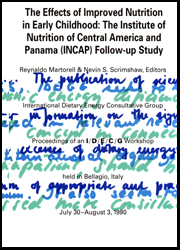 The
Effects of Improved Nutrition in Early Childhood: The Institute of Nutrition of Central
America and Panama (INCAP) follow-up study
The
Effects of Improved Nutrition in Early Childhood: The Institute of Nutrition of Central
America and Panama (INCAP) follow-up study The
Effects of Improved Nutrition in Early Childhood: The Institute of Nutrition of Central
America and Panama (INCAP) follow-up study
The
Effects of Improved Nutrition in Early Childhood: The Institute of Nutrition of Central
America and Panama (INCAP) follow-up studyReynaldo Martorell & Nevi S. Scrimshaw, Editors
International Dietary Energy Consultative Group
Proceedings of an I/D/E/C/G Workshop
held in Bellagio, Italy
July 30-August 3, 1990
THE JOURNAL OF NUTRITION OFFICIAL PUBLICATION OF THE AMERICAN INSTITUTE OF NUTRITION
APRIL 1995
SUPPLEMENT VOLUME 125 NUMBER 4S
Guest Editors:
Reynaldo Martorell and Nevin s. Scrimshaw
This supplement to The Journal of Nutrition is the responsibility of the guest editors, to whom the Editor of The Journal of Nutrition has delegated supervision of both technical conformity to the published regulations of The Journal of Nutrition and general oversight of the scientific merit of each article. Each article in this supplement was subject to strict peer review before publication, as are all articles published in The Journal of Nutrition. The opinions expressed in this publication are those of the authors based on independent research and are not attributable to the sponsors or the publisher, editor or editorial board of The Journal of Nutrition.
On behalf of the UN ACC-Subcommittee on Nutrition, the International Dietary Energy Consultative Group (I/D/E/C/G) has been established for the study of dietary energy intake in relation to the health and welfare of individuals and societies by the United Nations University. Its specific objectives are:
1. The compilation and interpretation of research data on functional and other consequences of deficiency, change or excess of dietary energy.
2. The identification of related research needs and priorities, and the promotion of needed research.
3. The publication of scientific and policy statements and other information on the significance of chronic deficiencies and excesses of dietary energy.
4. The identification and promotion of appropriate and practical means of corrective action.
I/D/E/C/G Steering committee:
The digitalization of this publication was made possible by a grant from the Nestlé Foundation- Dr. N.S. Scrimshaw, UNU,Chairman
- Dr. J.G.A.J. Hautvast, IUNS
- Dr. B. Schürch, Executive secretary
History and design of the INCAP longitudinal study (1969-77) and its follow-up (1988-89)(¹,²)
The INCAP longitudinal study (1969-77)
The INCAP follow-up study (1988-89)
Literature cited
Using the randomized design
Dose response to supplementation
Combining randomized and dose-response analyses
Differentiating among the contributions of energy and other nutrients
Conclusions
Literature cited
Age differences in the impact of nutritional supplementation on growths(¹,²)
Patterns of linear growth in rural Guatemalan adolescents and children(¹,²)
Age at menarche and nutritional supplementation(¹,²)
Early nutritional supplementation and skeletal maturation in Guatemalan adolescents(¹,²)
Nutritional supplementation during early childhood and bone mineralization during adolescence(¹,²)
Nutrition in early life and the fulfillment of intellectual potential(¹,²)
Results and Implications of the INCAP follow-up study(¹,²)